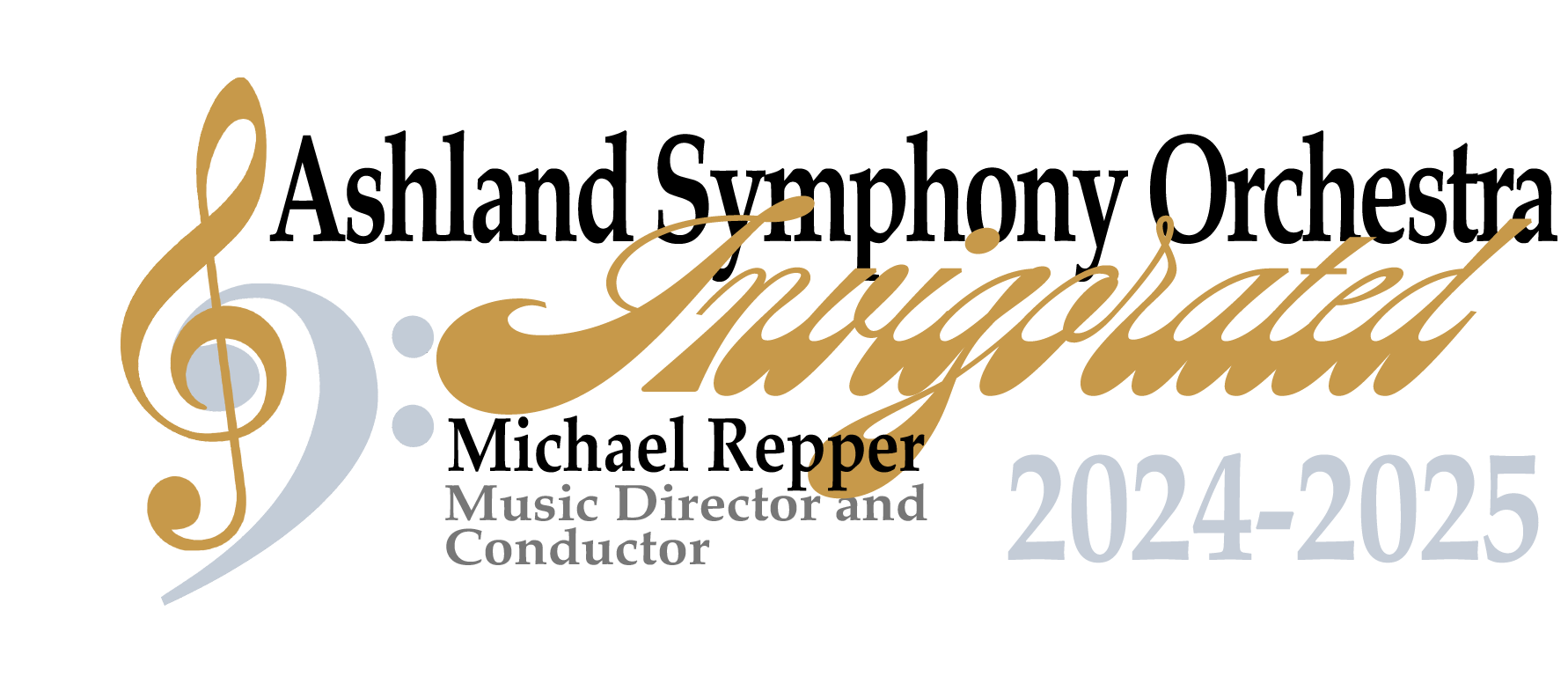Featuring Grace Park, violin
The Four Seasons – Antonio Vivaldi
The Four Seasons of Buenos Aires – Astor Piazzolla
Featuring Grace Park, violin
The Four Seasons – Antonio Vivaldi
The Four Seasons of Buenos Aires – Astor Piazzolla
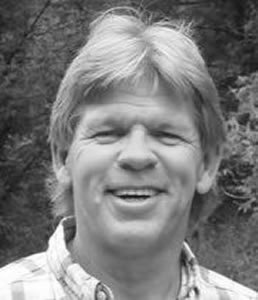 Dear Friends,
Dear Friends,
The Ashland Symphony Orchestra warmly welcomes you to our 55th season! Our Grammy Award-winning Music Director and Conductor, Michael Repper, with his unwavering enthusiasm, creativity, and passion, is embarking on his third year leading the orchestra. Michael continues to curate a diverse repertoire that blends both traditional and innovative selections, expanding the boundaries of ASO’s musical exploration. Guided by the exceptional talents of our ensemble of musicians, whom we wholeheartedly applaud for their outstanding contributions, we eagerly anticipate another year filled with high quality performances. Together, our musicians, conductor, board of directors, and Executive Director work in a collaborative spirit to deliver symphonic experiences that unite, educate, and enrich our community through the transformative power of orchestral music. Please join us on the journey. We hope you find it inspiring and refreshing. We sincerely thank you for your support.
Happy Listening!
Allan Andersen, President
ASO Board of Directors
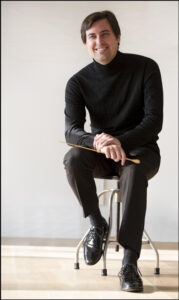
Dear Ashland Symphony Orchestra Patrons,
I’m finding it hard to believe that this is already the start of my third season as Music Director of the Ashland Symphony. Ashland is one of the most special places anywhere in the world. Nowhere else that I have traveled exhibits the same level of community spirit and harmony, two of the most important ingredients for sustaining orchestral music. The symphony truly lives up to its moniker of being a jewel of Ashland County — indeed it is a jewel of the world!
An Ashland Symphony Orchestra Fan Club member named this season “Invigorated!” I couldn’t agree more. Each concert packs an excitement that you will feel viscerally, and the orchestra will continue to cement its reputation for energetic performances and versatile programming. We look forward to performing music from across the spectrum, new and old, familiar and unfamiliar, in an accessible and inviting way. Please, don’t forget to come early to the pre-concert talks, where we have the opportunity to connect deeper about the music!
See you at Archer, everyone! It’s going to be a great year —
Michael Repper
Music Director and Conductor
Ashland Symphony Orchestra
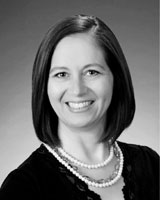
Here’s to another decade (I hope!) with the ASO. As the season title suggests, I am invigorated and looking forward to the exciting and unexpected works programmed by Michael Repper. This year will combine new pieces with old favorites and showcase music composed by women and people of color as well as the old masters; and we will share the stage with the magnificent violinist Grace Park and the Columbus duo Honey and Blue.
When I asked the Fan Club to help with titles for the season and the concerts, Ashland High School student Eva Early got to work. She came up with “Invigorated” and titled 4 of the 6 concerts. We are fortunate to have so many young listeners attend our concerts and support the ASO with their enthusiasm and volunteerism. For more information about the Fan Club, visit https://www.ashlandsymphony.org/fan-club/.
Be sure to invite your friends, family, and colleagues to come “Listen to what people are talking about!”
Martha Buckner
Executive Director
Ashland Symphony Orchestra
 Conductor Michael Repper’s work spans six continents. In 2023, he became the youngest North American conductor to win a Grammy® Award in Best Orchestral Performance. He has an international reputation for engaging and exciting audiences of all spectrums, and for promoting new and diverse musical talents.
Conductor Michael Repper’s work spans six continents. In 2023, he became the youngest North American conductor to win a Grammy® Award in Best Orchestral Performance. He has an international reputation for engaging and exciting audiences of all spectrums, and for promoting new and diverse musical talents.
Repper is currently the Music Director of the Ashland Symphony Orchestra, Mid-Atlantic Symphony Orchestra, and the Northern Neck Orchestra of Virginia. He recently concluded tenures as Music Director of the New York Youth Symphony at Carnegie Hall, and as Principal Conductor of Sinfonía por el Perú, the elite youth orchestras and choruses of one of South America’s most versatile social impact music programs. Repper was the Baltimore Symphony Orchestra Conducting Fellow for two seasons, and he served as the BSO’s New Music Consultant. Recognizing his success at these ensembles, and his growing profile as a guest conductor all over the world, Repper was awarded a Solti Foundation US Career Assistance Award in 2020, 2021, 2022, and 2023.
His album with the New York Youth Symphony, which features debut recordings of works by Florence Price, Jessie Montgomery, and Valerie Coleman, achieved widespread critical acclaim, reached #1 on the Billboard Chart, and won a Grammy® Award, marking the first time a youth orchestra achieved this milestone.
Repper has collaborated on large-scale productions of symphonic and theatrical works with the Weill Music Institute at Carnegie Hall, the Chicago Symphony Orchestra, Ravinia Festival, Peabody Institute of Music, and the New School of Music, among others. An avid pianist, he regularly performs as a soloist alongside his orchestras.
Alongside the standard repertoire, Repper is especially invested in programming new music and showcasing fresh talent. His ensembles have performed dozens of world premieres and pursued innovative commissions, as well as a variety of Carnegie Hall premieres from established and emerging composers.
His experience with choruses has been recognized with significant positions, including his tenure as the Music Director at the Baltimore Basilica, the first Catholic Cathedral in the United States. Internationally, Repper has performed with highly regarded ensembles and in the world’s greatest venues, including the São Paulo Symphony, and at the Palau de la Musica in Barcelona, Carnegie Hall, and others.
His discography includes the aforementioned album of music with the New York Youth Symphony, alongside an album with the Grammy®-Nominated Metropolis Ensemble and Grammy®-Winning Brooklyn Youth Chorus (“Musical America”), and several with the Peabody Institute as an Assistant Conductor. With the New York Youth Symphony during the Coronavirus pandemic, he was one of the first to pioneer the practice of distanced orchestral performance videos, and he made two performance appearances on CNN, the final one with Platinum-Artist Billy Ray Cyrus.
Repper complements his work with professional orchestras with a firm commitment to education, and travels worldwide to work with ensembles of young musicians. As Artistic Director of the Chamber Music Society of Maryland, he ushered in a slate of innovative educational programming, such as the Reinecke Youth Chamber Music Scholarship and Fellowship Program. He has conducted several masterclasses for orchestras from all over the United States on behalf of the New York Philharmonic, and conducts side-by-side and educational concerts with major orchestras, including the Baltimore Symphony, the Colorado Symphony, and the Sarasota Orchestra.
Repper’s most influential conducting mentors are Marin Alsop and the late Gustav Meier. He believes that a conductor’s main role is to connect people and to use performance as a vehicle for positive change. He aims to promote a diverse and inclusive future for the arts, and to pay forward the passion for community that his mentors demonstrated to him.
VIVALDI, Antonio: Le Quattro Stagioni, op.8, nos.104 (The Four Seasons) <1717>
Instrumentation: Solo violin, Strings, Harpsichord continuo
Duration: 37 minutes
Antonio Vivaldi was the most important composer of the Italian Baroque period, although appreciation of that fact was slow in coming in later times. But, during his lifetime he was celebrated all over Europe, and his compositions were highly influential—mostly notably on J. S. Bach. He wrote almost fifty operas but is remembered now for his amazing fecundity in composing instrumental works. He wrote about five hundred concertos (not as one unappreciative wag once said, “the same concerto five hundred times.”) While many of them feature wind instruments, most are for strings and are practically an early eighteenth-century compendium of almost every imaginative passage or technique.
Vivaldi early on was ordained into the priesthood, and his probable red hair gave him the moniker, “the red priest.” He was a teacher on and off for most of his life at the Ospedale della Pietà in Venice (you can still see the building, today, just down the quay from St. Mark’s Cathedral.) The institution was basically a girls’ school for children born to the Venetian nobility under awkward circumstances, shall we say? The school had very high musical standards, and the quality of its student orchestras was legendary. Vivaldi, however, was a great traveler, moving around Italy working for various patrons, and taking up residencies here and there in opera houses. His publications swept Europe, and he was influential in establishing many conventions of eighteenth-century musical composition. His 1725 publication, Il Cimento dell’ Armenia e dell’invenzione, contained twelve concertos, seven of which had descriptive titles, including The Four Seasons. The others were The Hunt, Pleasure, and Storm at Sea.
The Four Seasons consists of four concertos for solo violin and string orchestra. Each concerto—in typical Vivaldi fashion—consists of three movements, the tempos of which are always respectively fast, slow, and fast. Not only did he give each of them the title of a specific season, he is also the presumed author of the four sonnets, each of which corresponds to a respective concerto. From listening to so many orchestral compositions of the nineteenth century that have a “program,” or story, that the music putatively illustrates or tells, audiences today have come to regard program music as practically the norm. But, for early audiences it was quite the novelty—yes, the tradition went back to the Greeks, but it was a rather thin one.
As one listens to each of the twelve movements of the four concertos, the “roadmap” is fairly clear. Each opens with a section for the complete orchestra (the ritornello), followed by a section for solo violin, accompanied by the orchestra—or a few members of them. The ritornello and solo sections alternate—about three times—ending with a final ritornello. The solo sections vary in themes and textures, but the ritornelli generally cover the same material, so you can usually spot them when they return—although Vivaldi usually altered them a little each time.
It is marvelous how the composer is able to evoke the sounds, situations—even the temperatures!—of the various seasons, using only imaginative string figurations, melodies, and tempos. He does not need all the resources of the modern orchestra, at all. Taken from the accompanying sonnets, Vivaldi tells us to expect birds and thunderstorms in the first movement of “Spring,” the sleeping, faithful dog of the goatherd in the second, and nymphs and shepherds dancing to bagpipes in the third movement. “Summer” brings us blazing sun and scorched pine trees in the first movement, and a summer storm with hailstones in the other movements. “Autumn” brings us rustic peasants celebrating the harvest in the allegro, sleeping off the effects of wine in the second movement, and a vigorous hunt with dogs and horns (ending tragically for the quarry) in the last movement. Finally, “Winter” comes with shivering, frosty snow, and chattering teeth. The second movement depicts contentment by the fire—not worrying about the poor folks drenched outside by the rain. And the last movement brings slipping on icy paths and skittering across frozen waters. One can feel the “cold wind blowing through the house, despite locked and bolted doors.”
–Wm. E. Runyan
© 2015 William E. Runyan
| Spring – Concerto in E Major
Allegro Largo Allegro |
Spring – Concerto in E Major
Allegro Largo Allegro |
| Summer – Concerto in g-minor
Allegro non molto Adagio e piano – Presto e forte Presto |
Summer – Concerto in g-minor
Allegro non molto Adagio e piano – Presto e forte Presto |
| Autumn – Concerto in F Major
Allegro Adagio molto Allegro |
Autumn – Concerto in F Major
Allegro Adagio molto Allegro |
| Winter – Concerto in f-minor
Allegro non molto Largo Allegro |
Winter – Concerto in f-minor
Allegro non molto Largo Allegro |
PIAZZOLLA, Astor: The Four Seasons of Buenos Aires (Desyatnikov) (Cuatro estaciones porteñas)
Verano Porteño (Summer) <1965>
Invierno Porteño (Winter) <1969>
Primavera Porteño (Spring) <1970>
Otoño Porteño (Autumn) <1970>
Tango, originally for quintet [pianoforte, electric guitar, bandoneón, violin/viola, double bass] arranged and reconfigured for solo violin & string orchestra by Leonid Desyatnikov (1996-1998), who adds quotations from Vivaldi’s The Four Seasons.
Instrumentation: Solo violin, Strings
Duration: 25 minutes
Every artist aspires to develop a personal voice, and every good artist eventually does so. But few arrive at a style so personal and so reflective of a unique vision that, while nonetheless achieving great international popularity, it is strictly sui generis. The music of Astor Piazzolla is just that. Single handedly he created a musical genre and style that began with the traditional elements of the Argentine tango, but was infused with so much of advanced twentieth century “classical” techniques, that the result almost obscures its popular roots. Jazz, Stravinsky, Bartók, dissonance, counterpoint, ubiquitous chromaticism, and varied orchestration—they all are incorporated into Piazzolla’s musical take on the tango. His achievement might be compared to a hypothetical situation wherein Stravinsky decided to base all his compositions—with all his modernist, challenging elements—on a transformed Viennese waltz. Just one genre subjected to almost every new cutting-edge technique. That would be personal, indeed! Yet, Piazzolla with his more than one thousand compositions, has achieved something like that. Ravel did something like that in his La valse, but that was just once. While many aficionados of traditional tango music—especially in Piazzolla’s native country, Argentina—are less than thrilled with his approach, he has garnered an enthusiastic following around the world with audiences and a variety of professional musicians.
Piazzolla was born in Argentina, but moved with his parents in 1924 to New York City, living in Greenwich Village, immersing himself in the musical culture and atmosphere of the great city. Jazz, classical music, the blues—all were his métier—all the while his family exposed him to traditional Argentine music at home. And although he and his music are inextricably bound to the sound of the bandoneón (the indigenous Argentine accordion, rather like a concertina), it was, indeed in New York City that his father brought home from a pawnshop, little Astor’s first bandoneón. All the while Piazzolla studied classical music, simultaneously composing his first tangos. A meeting with the tango immortal, Carlos Gardel (of Por una Cabeza fame), cemented his life-long dedication to the genre.
He moved back to Argentina in 1936, and there ensued a long and remarkable career as composer of tangos and performer in myriad musical groups—all the while pursuing a side interest in classical musical composition. Moving well ahead in his career, by the early fifties he was immersed in the study of Stravinsky and Bartók, studying composition with Ginastera, listening to lots of jazz, and composing “classical” music. In 1953 he won a major prize with a symphony that he had composed and was off to Paris to study with the famed Nadia Boulanger—teacher of such luminaries as Aaron Copland, Philip Glass, and Elliott Carter. Savvy woman that she was, she disabused Piazzolla of dreams of becoming another Bartók, and insisted that he must acknowledge his brilliance in the tango, and follow it for his success. And so, he did, but not without taking with him his deep engagement with the techniques of jazz, blues, and complicated contemporary art music. The result was his unique style, what is often called nuevo tango.
In the following years he became a legend in his native country, composing hundreds of pieces, continuing to play in and lead many different tango orchestras, and building a worldwide reputation. Typically, his works were performed by a small tango group, generally, but not always, consisting of bandoneón, violin, electric guitar, double bass, and piano. Inevitably, his compositions were also transcribed for a large variety of instrumentations. He toured the world, almost Zelig-like, appearing on television, in concerts, recording with a variety of artists—a true universal musician. He composed chamber music, orchestral music, and made music with everyone from Gerry Mulligan to Mstislav Rostropovich.
The Four Seasons of Buenos Aires has as its origin a single composition in one movement, Buenos Aries Summer, written in 1965 for a play. Piazzolla subsequently wrote Autumn in 1969, and the other two in 1970. They were scored for the instruments in his traditional tango quintet and were not envisioned as a suite—just four separate compositions. In the early 1990s someone else put the four together and arranged them for woodwind quintet, three violoncellos, and bass. Then in the late 1990s the Russian violin virtuoso, Gidon Kremer, commissioned composer, Leonid Desyatnikov, to completely redo the piece, changing it into a work for virtuoso solo violin, accompanied by string orchestra. Among the substantial changes to the work, were added allusions to the immortal Four Seasons of the eighteenth-century composer, Antonio Vivaldi. Desyatnikov is somewhat of a wag, as one will see.
The result is a remarkable composition that is a panoply of string effects right out of the string quartets of Bela Bartók, harmonies and snatches of melody from traditional tangos of the 1930s, exaggerated, jagged syncopations that almost parody the old tango, and a kaleidoscope of harsh dissonances juxtaposed with sudden consonant passages. The added solo violin part is a tour de force virtuosic swagger, replete with dramatic solo cadenza-like sections. Throughout, one is kept constantly off guard by unexpected changes in dynamics and tempos. While each movement is named after a season, and there are a variety of moods within each, there is not a lot of specific pictorial reference to the actual seasons, as in Vivaldi’s famous work. The allusions to Vivaldi are not that frequent, but occasionally, the arranger, Desyatnikov, will surprise one with a quote, most notably in the “summer” movement, but in the “spring,” as well (at the end). From time to time, a very Baroque fugue will take the stage, and then an equally novel blues inflected melody. Vivaldi-style pizzicati contrast with Bartókian “scratches” on the strings. In many ways, this work is all over the stylistic and historical map, but the genius of Piazzolla and Desyatnikov somehow make it all hang together in remarkably entertaining and clever composition. It has few imitators.
–Wm. E. Runyan
©William E. Runyan
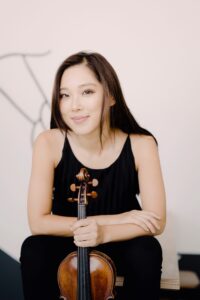 Praised by the San Francisco Chronicle as being “fresh, different and exhilarating” and Strings Magazine as “intensely wrought and burnished“, violinist Grace Park captivates audiences with her artistry, passion and virtuosity. Winner of the Naumburg International Violin Competition, she is one of the leading artists of her generation.
Praised by the San Francisco Chronicle as being “fresh, different and exhilarating” and Strings Magazine as “intensely wrought and burnished“, violinist Grace Park captivates audiences with her artistry, passion and virtuosity. Winner of the Naumburg International Violin Competition, she is one of the leading artists of her generation.
Ms. Park’s has made her most recent solo debuts at Colorado Music Festival, Bard Festival under the baton of Leon Botstein, Stern Auditorium at Carnegie Hall with the New York Youth Symphony, The Rudolfinum/ Dvorak Hall in Prague with Prague Philharmonia, and recital debuts at Krannert Center, Beethoven Minnesota Festival and Merkin Hall.
Future collaborations include her debut at Seoul Arts Center with Les Musiciens du Louvre with Maestro Marc Minkowski, Sarasota Orchestra with Maestro Peter Oundjian, Orlando Philharmonic with Maestro Eric Jacobsen, Savannah Music Festival and Camerata Pacifica.
Ms. Park recorded her debut solo album with the Prague Philharmonia and their music director, Emmanuel Villaume, which includes concertos and solo works of Mozart and Dvorak. It is set to be released in the spring of 2025.
A devoted and passionate educator, Ms. Park is an alumnus of Carnegie Hall’s Ensemble Connect and has taught masterclasses and coached at Conservatorio de Musica de Cartagena, Mannes School of Music, University of North Carolina, University of Mississippi, Washington and Lee University, North Dakota State University, Skidmore College, among others.
As a native of Los Angeles, California, Ms. Park began violin at the age of 5 where she trained at the Colburn School of Music. She continued her studies at Colburn Conservatory and New England Conservatory for her Bachelor and Master of Music degrees. Principal teachers are Donald Weilerstein, Miriam Fried, Sylvia Rosenberg, and Robert Lipsett. She now resides in New York City.
She performs on a 1717 Giuseppe Filius Andrea Guarneri on loan from an anonymous sponsor.
https://www.graceparkviolin.com/
Samuel Rotberg, Concertmaster
James E. Thomas Endowed Chair
Jane Reed
Stephen Domka
Shalem Loritsch
Mary Kettering, Principal
Ania Kolodey
Wanda Sobieska
Eva Mondragón, Principal
Joshua Bowman
Lee Wilkinson
Jeffrey Singler, Principal
Rosa Balderrama
Sarah Tindall
Bryan Thomas, Principal
Jeff Weeks
Michael Repper
Our ushers and volunteers
Philip McNaull, Technical Director
Aidan Campbell, Assistant Technical Director
Seth Morrison, Stage Manager
Bryce Bishop, Assistant Stage Manager
Jen Burford, House Manager
Ashland City Schools for its continued support of the arts
Roger Price, Professional Voice Actor & Announcer, www.RogerzVoice.com
Please silence all electronic devices.
No flash photography or audio/visual recording permitted.
No food or drink permitted in the Robert M. & Janet L. Archer Auditorium.
The individuals and associations listed on this page, by their support of the orchestra’s operating fund, make possible the continuance of the Ashland Symphony Orchestra. Additional support is needed and will be most welcome at any time throughout the year. If there is an error, please notify the office. Donations listed as of 10/18/24.
Celebrate A Birthday! Welcome A New Neighbor! Honor A Memory! Celebrate A Promotion!
The Ashland Symphony will recognize the people or events in your life with a letter that you have donated in their honor to the Ashland Symphony Orchestra. Please send us that person’s name, address and the event along with your donation and we will send a personalized note acknowledging your thoughtfulness along with the printed celebration text in the upcoming program. Call 419-289-5115 for more information.
‡Sponsor – sponsorships are still available for this season. Call 419-289-5115.
*Additional gift given to the Change for Music Education Campaign
Pacesetters – patrons who pledged on or before July 31, 2023 are indicated in bold.
Name in italics – increased pledge by at least 10%
NAME IN ALL CAPS – increased pledge to move up to a new giving level
Robert M. and Janet L. Archer‡
Ashland University, in-kind support
Hugo H. and Mabel B. Young Foundation
Ohio Arts Council
Samaritan Hospital Foundation‡
Susan Lime
Trinity Lutheran Church – Rybolt Fund‡
Charles and Peggy Ulrich
Anonymous
Ashland City Schools‡
Stan and Diana Brechbuhler
Forrest Conrad
THOMAS AND KRISTIE DONELSON‡
Barbara Glenn
Grandpa’s Cheesebarn & Sweeties Chocolates‡
Michael and Seiko Hupfer
Antonio and Karen Marallo
Alan and Marjorie Poorman
BCU Electric‡
CHARLES AND MELODY BARNES
Martha Buckner
James and Kristi Cutright
JEAN DIERCKS
GRETCHEN AND G. DAVID EMERY
BETTI AND JOHN FRAAS
Catherine Hiner
TERRI COOPER HUDSON
Bud and Cuda Ingmand‡
David C. Kowalka
PACKAGING CORPORATION OF AMERICA‡
John and Diane Paulson‡
PEACE EVANGELICAL LUTHERAN CHURCH‡
Jon Parrish Peede and Rev. Nancy Hollomon-Peede
John and Dana Sherburne*
John and Jeanie Shultz
Spreng Smith Agency‡
Wappner Funeral Directors
Dr. JoAnn Ford Watson*
ALLAN AND MARY-ROSE ANDERSEN
Ron and Lisa Blackley
John and Lori Byron
Angie and Adam Cirone
RON AND CAROLYN MARENCHIN‡
Thomas and Jane Reed
Bill and Chris Strine
Dr. Stephen and Peggy Yoder*
BAKER BOWMAN & CO.
Dr. Sara Battison
Bella’s 220‡
Doug and Susan Blake
Brethren Care Village‡
TED AND PATRICIA BYERLY
Doug and Ruth Cellar
Betsy Chapman
Charles River‡
Coldwell Banker Ward Real Estate
Comfort Control‡
Tim and Anne Cowen
Robert and Jan Cyders
BROOKE DaHINDEN
Ray and Cherie Dever
Explore Ashland‡
Dr. Lucille Ford
Don and Barb Gilbert
Robert and Vickie Groenke*
ED AND KAREN GROSE
Louise E. Hamel
Jan W. and Sharon Howe
Loretha Kline
Stan and Carol Kopp
Lighthouse Wealth Management‡
Dann and Connie Marble*
Mel McKeachie and Melody Snure
Tom and Mary McNaull*
Miller’s Hawkins Market‡
PAM AND MIKE MOWRY
KEVIN AND CAROL OBERHOLTZER
Bob and Jayne Roblin*
GORDON AND JANE RUGGLES
Debbie Seaman*
D.R. and C.L. Sedwick
SARAH SHEPHERD
Dorothy Stratton*
Michael and Deborah Sulllivan
Robert and Trina Swan
Ralph and Betty Jo Tomassi
Ann and Scott VanScoy
Russell and Jan Weaver
Whitcomb & Hess Inc.
Tim and Linda Workman
Abbott Laboratories
Lucy Amsbaugh
Myron and Carolyn Amstutz
Ashland Noon Lions
SHIRLEY BOOKMYER
Joe and Pat Denbow
Roger and Nancy Fox
Dr. Robert and Susan Gregg
Janet Hamilton
Dan and Linda Hawk*
Henry and Norma Hiner
Barbara Hoshiko
Irwin & Associates, CPA’s
RON AND BARB LEDDY
TIM AND BEVERLY MCMILLAN
JACK AND DIANE MESSNER
Ken and Sheila Milligan
Larry and Diane Moretz
Dick and Carol Obrecht
DAN AND LISA PETERSON
Lana M. Potter
Thomas and Diane Rohr
ST. MATTHEW’S EPISCOPAL CHURCH
Glen and Judy Stewart
Gene and Sally Telego
LEROY WEAVER
Hal and Betsy Weller
Susan Whitted
Daniel and Rita Wierbiki
Steven and Marla Willeke
Sally Ahlers
Larry Ames and Teresa Durbin-Ames
ASHLAND MUSICAL CLUB
William L. Buckingham
Law Office of Andrew Bush
Dr. and Mrs. Thomas Castor
MADELINE COLE
Dennis and Polly Davis
Dave Early
John and Diane Emser
David and Debby Gray*
Gene and Jan Haberman
Tom and Chris Herron
Gary and Cheryl Hildebrand
Rebecca Humrichouser*
Stanley and Joyce Hunt
Bob and Colleen Jackson
Tom and Marilyn Koop
John and Laurie Maurer
Maurer Photography
Shirley Minner
Barb Queer
KAREN REAUME
Jane Roland
Rita M. Roper
Patty Saunders and Soren Brauner
Paul and Barbara Schantz
Jack and Nancy Smith
Rev. Tom and Kitty Snyder
Michael and Nancy Udolph
RUSS AND KATHY WHISLER
RON AND JP WHITELHILL
Dr. JoAnn Ford Watson in memory of Dr. Lucille Ford
Anonymous
DOUGLAS AND REBECCA ABEL
Ashland Board of Realtors
Athena Study Club in memory of Donna Weaver
Jeffrey and Diane Bonfiglio
Joe Gorsuch
Darcie Gilbert and Chris Koch*
Kay Krueger
Bonnie Graves
FRANCES HAMILTON
Justin Hylden
Bill and Barb Latham
Alice L. Metcalf
Patricia Peck
Patricia Perez in memory of Donna Weaver
Petal Pushers Garden Club in memory of Donna Weaver
James H. Prinz
Doug and Natalie Scott
S. Kris Simpson
Dale and Jody Thomae

In 1997, Bob and Jan Archer established the first donor fund through the Ashland County Community Foundation to benefit the Ashland Symphony Orchestra. The ASO then partnered with the ACCF in 1999 and created the “Ashland Symphony Orchestra Fund in Memorium of James E. Thomas”. Since then, three new agency funds and fourteen additional donor advised or designated funds have been established! The Ashland County Community Foundation can assist you in creating a fund to benefit the Ashland Symphony Orchestra now or as part of your estate plan. For more information, call the Foundation at 419-281-4733.
Donations may be made to existing endowments at any time. Contact the Foundation for more information www.ashlandforgood.org.
*To contribute to these funds, please send donation to Ashland Symphony Orchestra, 401 College Ave., Ashland, OH 44805.
Robert M. & Janet L. Archer Fund est. 1997
Ashland Symphony Orchestra Fund in Memorium of James E. Thomas est. 1999*
ASO Podium Endowment Fund in Honor of Maestro Arie Lipsky est. 2018*
ASO Harold Weller Music Education Endowment Fund est. 2019*
gift from Nick & Edna Weller Charities: Harold & Betsy Weller and Thomas Weller
ASO Rev. John H. Landrum Memorial Endowed Chair for Flute 2 est. 2020*
gift from Marybelle H. Landrum
Ashland Symphony Orchestra est. 2000
Mary M. Case Memorial Fund est. 2005
Ann K. Guthrie Fund est. 2009
Arie Lipsky Honorary Endowment Fund est. 2010
Kopp Family Fund est. 2011
Dr. Alvin W. Garrett Fund est. 2017
William and Marlene Rose Fund est. 2017
J. Robert and Ruth L. Tipton Fund est. 2017
Dr. JoAnn Ford Watson Fund est. 2017
Dr. Beverly Bixler Fund est. 2018
Billy Harris Charitable Fund est. 2018
Lawrence and Catherine Hiner Endowed Chair for Percussion of the ASO Fund est. 2020
John R. Donelson for the benefit of the ASO est. 2021
Elizabeth Pastor Fund for the benefit of the ASO est. 2021
F. Dean and Joan Bartosic Family Fund for the benefit of the ASO est. 2023
This site uses cookies. Find out more about cookies and how you can refuse them.
New membership are not allowed.
